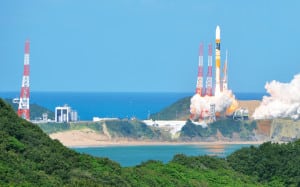Latest News
[Via Satellite 12-15-2015] Japan is enthusiastic that changes being implemented through its most recent “Basic Plan on Space Policy” are showing the first fruits of revitalizing and stabilizing the country’s space industry. Speaking Dec. 10 at a Maureen and Mike Mansfield Foundation event in Washington, D.C., Yoshinori Komiya, director general of Japan’s Office of National Space Policy, said that in the two years since the plan was introduced, it is already having a modernizing impact on the nation.
Komiya said one of the biggest changes reflected in the new plan was the need for a clear long-term public investment plan. This in the past grew to be such a problem that it stunted the growth of the island nation’s domestic space sector.
“The lack of foreseeability has weakened the Japanese industry,” he said, adding that the “the Japanese space industry has decreased for this decade.”
Komiya described two primary parts of Japan’s “Space Basic Plan,” with the first being maintenance, and the other being implementation. This includes amending the plan once a year, which he said happened just recently ahead of his U.S. trip. Japan’s Office of National Space Policy has also achieved greater long term planning into the schedule for launching satellites, despite some political resistance, giving industry more motivation to invest.
“I received various comments from our Japanese space industry that they can easily foresee and they can invest the technology and the human resources on the space mission. So I believe the outer space basic plan already starts to make sense to revive the Japanese space industry,” he said.
The U.S. plays an influential part in Japanese space policy. Chirag Parikh, director of space policy at the U.S. National Security Council said Japan has been one of the most collaborative nations with the U.S. in space, with delegations from both countries meeting nearly every month. Of particular importance, he said, is the ability to collaborate in commercial, civil and, more recently, in defense space programs.
“Because of the change in the basic space law, it allowed for [the Japan Aerospace Exploration Agency] JAXA to be able to work with the Ministry of Defense, and with the Department of Defense to look at Space Situational Awareness (SSA) data and see how it will be able to support national security purposes, [and] civil space traffic management purposes,” said Parikh.
SSA, along with maritime situational awareness, are two areas where Parikh said otherwise disparate space programs can work together, and are top areas where Japan and the U.S. can support each other.
Komiya also expressed optimism at the opportunity for the U.S. and Japan to work together not only in civil and commercial space, but also in defense, saying that after World War 2, the U.S. government’s disposition against Japanese rearmament siloed Japan’s space program into scientific study. Space debris and Anti-Satellite (ASAT) experiments are becoming frequent talking points in the current Japanese administration, he said.
“The space security issue is so important in concerning our space policy. Therefore, in the context of the U.S.-Japan security alliance, space has become one of the key issues,” he said.
Komiya listed ensuring space security as the number one goal of Japan’s space basic plan, followed by promoting the use of civil space, and bolstering industry and science. He said it is the diplomatic importance of U.S.-Japan cooperation that is influencing Japan’s decision to partner on extending the International Space Station (ISS) to 2024.
“We are not there yet, but we are very close,” added Parikh. “We are having conversations about the extension of the space station with the government of Japan through 2024. But we are very encouraged by what is happening in that vein.”
Parikh said there is greater opportunity for cooperation in space between the U.S. and Japan because, compared to U.S. partnerships with other space-savvy nations, Japan is advanced in many different disciplines. He highlighted Japan’s progress with its Information Gathering Satellites (IGS), which Komiya said are to number 10, and also mentioned Japan’s Global Navigation Satellite System (GNSS), the Quazi-Zenith Satellite System (QZSS) as an area for potential partnership.
“The government of Japan is developing a great architecture of QZSS satellites. What can we do with QZSS satellites and GPS satellites? There is opportunity for enhanced capabilities, there are opportunities for resiliency, there are opportunities for even hosted payload capabilities,” said Parikh, adding that resiliency is an area of future collaboration that the U.S. is evaluating today.
Komiya said Japan recently set up a task force on boosting the country’s international presence in the space industry. In 2015 Japan had some international highlights, including the Mitsubishi Electric-built Turkish satellite Turksat 4B reaching orbit in October, and Mitsubishi Heavy Industries (MHI) launching the Canada-based Telesat’s Vantage 12 satellite aboard an H2A rocket. Japan is also setting up a “space economic creation network” called S-NET to bring together companies in space and Information Technology (IT). Komiya said that, similar to investment interest in space shown by U.S. tech giants like Facebook, Google and Samsung, companies in Japan traditionally separate from the space industry are starting to look skywards with their investments.
Get the latest Via Satellite news!
Subscribe Now